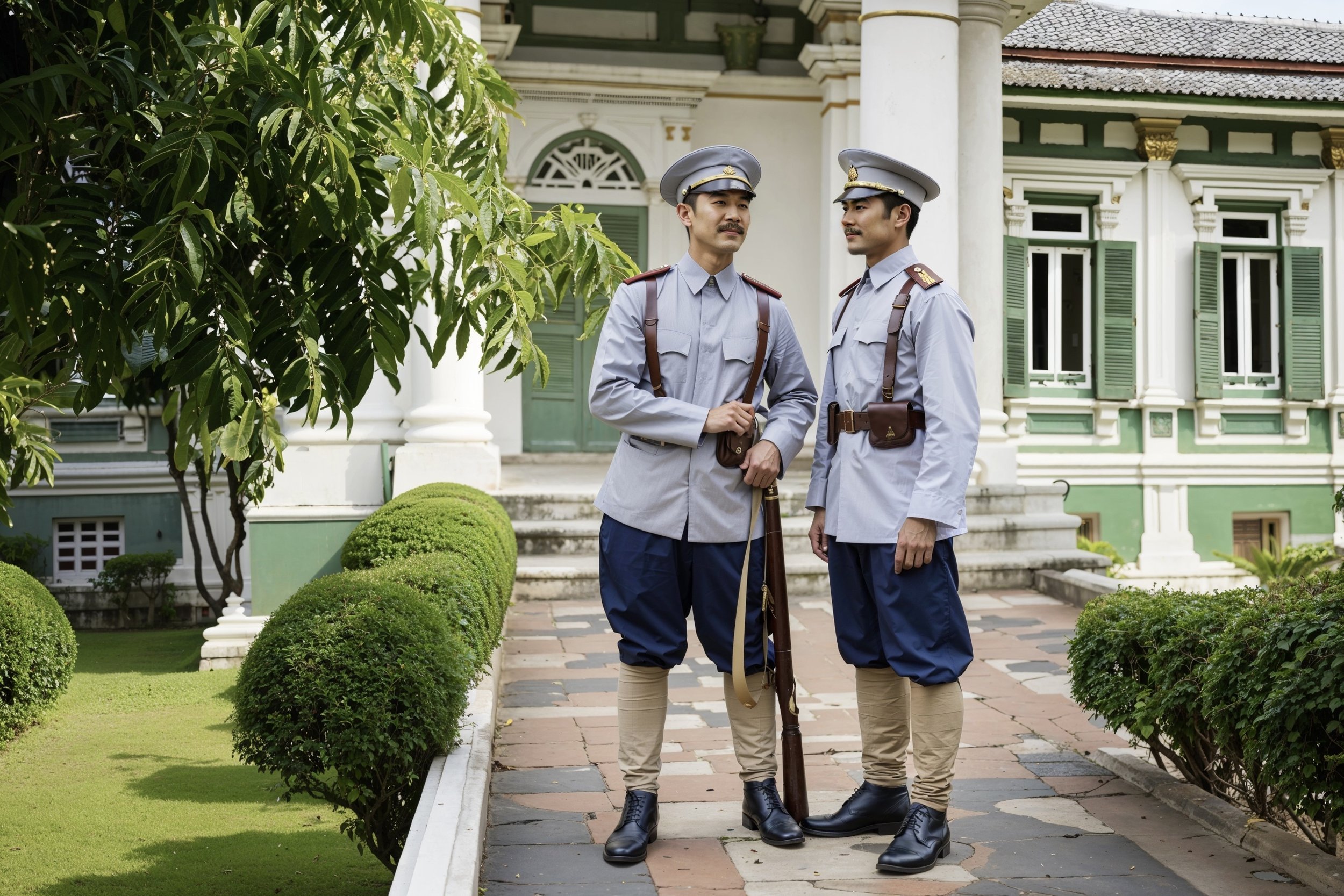ภาพ ความทรงจำ และประวัติศาสตร์: แนวคิดประวัติศาสตร์นิพนธ์เชิงทัศนาในงานสร้างสรรค์ภาพในประวัติศาสตร์ด้วย AI
ภาพ ความทรงจำ และประวัติศาสตร์: แนวคิดประวัติศาสตร์นิพนธ์เชิงทัศนาในงานสร้างสรรค์ภาพในประวัติศาสตร์ด้วย AI
ภาพชุด AI นี้เป็นผลลัพธ์จากการลงสีภาพถ่ายขาวดำในโพสต์ก่อนหน้า ซึ่งกล่าวถึงเครื่องแบบทหารในช่วงต้นรัชสมัยพระบาทสมเด็จพระมงกุฎเกล้าเจ้าอยู่หัว รัชกาลที่ ๖ แม้ผลงานครั้งนี้จะประสบความสำเร็จในการถ่ายทอดอารมณ์ สีสัน และบรรยากาศของยุคนั้นได้อย่างน่าพึงพอใจ แต่รายละเอียดบางประการ เช่น อินธนู (epaulette) เครื่องหมายบนเครื่องแบบ เหรียญตรา และสัญลักษณ์ประจำยศ ยังไม่ได้รับการสร้างให้ตรงตามต้นฉบับอย่างครบถ้วน ทั้งนี้เนื่องจากการสร้างสรรค์ในครั้งนี้มุ่งเน้นการผลิตต้นแบบเพื่อใช้อ้างอิงในด้านสไตล์โดยรวม อันครอบคลุมทั้งโครงสร้างการตัดเย็บ วัสดุ และโครงร่างของเครื่องแบบ เพื่อประโยชน์ในการออกแบบเครื่องแต่งกายและการสร้างแพตเทิร์นต่อไป เครื่องหมายต่าง ๆ ซึ่งถือเป็นองค์ประกอบสำคัญนั้น จำเป็นต้องมีการสร้างแม่พิมพ์และตัวอย่างแยกในขั้นตอนถัดไปครับ ผมได้เพิ่มภาพอุณาโลมสำหรับติดหมวก และเข็มกลัดติดคอเสื้อไว้ในโพสต์นี้เพื่อใช้เป็นเรฟเฟอเรนซ์เบื้องต้นด้วยเช่นกัน
สำหรับการเทรนโมเดล Flux LoRA ในครั้งนี้ ผมได้รับภาพถ่ายต้นฉบับขาวดำที่มีคุณค่าทางประวัติศาสตร์อย่างยิ่ง พร้อมคำแนะนำเชิงวิชาการที่เป็นประโยชน์อย่างมาก ทำให้สามารถลงสีได้อย่างถูกต้องและใกล้เคียงกับข้อเท็จจริงทางประวัติศาสตร์ โดยเฉพาะในเรื่องโทนสีของเครื่องแบบในช่วงก่อนปี พ.ศ. 2457 ซึ่งเป็นช่วงที่กองทัพสยามยังใช้เครื่องแบบตาม “พระราชนิยม” (parachaniyom) ที่ได้รับอิทธิพลจากเครื่องแบบทหารอังกฤษ ซึ่งรัชกาลที่ ๖ ทรงพบเห็นระหว่างทรงศึกษาที่ประเทศอังกฤษในขณะทรงพระเยาว์
การสร้างสรรค์ภาพคอลเลกชันนี้จึงนับเป็นทั้ง งานสร้างสรรค์เชิงทดลอง และ เอกสารอ้างอิงเชิงประวัติศาสตร์ ที่ช่วยรังสรรค์ภาพซึ่งไม่เคยมีอยู่จริงในอดีต และเป็นส่วนหนึ่งของการสร้าง ประวัติศาสตร์นิพนธ์เชิงภาพ ในมิติใหม่
เครื่องแบบของยุคนี้ประกอบด้วยเสื้อทูนิคและหมวกสีเทา อินธนูสีแดงทอง กางเกงแบบ breeches สีกรมท่า สวมกับรองเท้าบู๊ตขี่ม้าหรือรองเท้าทหารสีดำ พร้อมเกเตอร์หนังหรือผ้าพันแข้งสีน้ำตาล สิ่งที่น่าสนใจคือ ในช่วงปลายรัชกาลที่ ๕ ซึ่งยังใช้เครื่องแบบสีเทาในลักษณะเดียวกันนั้น ยังมีทหารชั้นผู้น้อยบางนายที่ไม่ได้รับแจกแม้กระทั่งรองเท้า สะท้อนให้เห็นถึงข้อจำกัดด้านทรัพยากร และความไม่สม่ำเสมอในการปรับตัวเข้าสู่ความเป็นสมัยใหม่ของกองทัพในยุคนั้น เราสามารถสังเกตข้อเท็จจริงเหล่านี้ได้จากภาพถ่ายต้นฉบับร่วมสมัยที่ยังคงหลงเหลืออยู่
สิ่งที่ผมประทับใจเป็นพิเศษเกี่ยวกับการใช้ AI ในการสร้างสรรค์ผลงานประเภทนี้ คือ AI ไม่ได้เป็นเพียงเครื่องมือสำหรับการสร้างภาพใหม่เท่านั้น แต่ยังสามารถทำหน้าที่เป็นเครื่องมือในการบูรณะ ฟื้นฟู และตีความประวัติศาสตร์ในมิติใหม่ ๆ ที่เราไม่เคยเข้าถึงมาก่อน เครื่องมืออย่าง Flux Kontext, Midjourney Editing Suite, Krea Edit และ Freepik Edit ล้วนเป็นองค์ประกอบสำคัญในการทำงานของผม ช่วยให้สามารถลงสี ปรับแสง เพิ่มองค์ประกอบ และสร้างบริบทใหม่ในภาพถ่ายเก่าได้อย่างแม่นยำ เป็นอีกหนึ่งมิติที่ช่วยให้เราเข้าถึงอดีตได้อย่างลึกซึ้งยิ่งขึ้น
แม้แนวคิด Visual Historiography หรือ “การเขียนประวัติศาสตร์ผ่านภาพ” จะได้รับการพูดถึงในแวดวงวิชาการระดับสากล แต่ในภาษาไทยยังไม่มีคำแปลอย่างเป็นทางการที่บัญญัติโดยราชบัณฑิตยสถาน ผมจึงขอเสนอคำว่า “ประวัติศาสตร์นิพนธ์เชิงทัศนา” เพื่อใช้อธิบายแนวทางการสร้างและตีความประวัติศาสตร์ผ่านภาพ โดยเฉพาะในรูปแบบที่ผสานข้อมูลทางประวัติศาสตร์เข้ากับศิลปะและเทคโนโลยีร่วมสมัย
ในบริบทของการศึกษาประวัติศาสตร์ คำว่า Visual Historiography มีความหมายเฉพาะ คือไม่ได้หมายถึงแค่การดูภาพในฐานะเอกสาร แต่เป็นการศึกษาว่าภาพต่าง ๆ เหล่านั้น "เล่า" ประวัติศาสตร์อย่างไร ใครเป็นผู้สร้างมันขึ้นมา และมันมีผลอย่างไรต่อการจดจำอดีตในแต่ละสังคม ภาพสามารถสะท้อนอำนาจ ความทรงจำ ความหลงลืม และอคติได้ไม่แพ้ข้อความ ดังนั้น visual historiography จึงไม่ใช่แค่การวิเคราะห์ภาพ แต่เป็นการวิพากษ์วิธีคิดที่อยู่เบื้องหลังภาพและการสร้างสรรค์ภาพเหล่านั้นด้วย
งานของผมอยู่ในแนวทางใหม่ของประวัติศาสตร์นิพนธ์เชิงทัศนา ซึ่งไม่ได้จำกัดอยู่แค่การวิเคราะห์ภาพในอดีต แต่รวมถึงการสร้างภาพใหม่ด้วย AI ที่วิเคราะห์ประวัติศาสตร์ ที่การสร้างสรรค์ภาพมาจากฐานข้อมูลจริง ไม่ใช่เพื่อความคิดถึง หรือจินตนาการลอย ๆ หากแต่เป็นการตั้งคำถามเชิงวิพากษ์ว่า — ใครมีสิทธิ์ “มองเห็น” หรือสร้างภาพแทนอดีต? — อะไรคือหลักฐานที่เรานับว่า “เชื่อถือได้”? — และรูปแบบของภาพที่สร้างด้วย AI ส่งผลต่อความหมายทางประวัติศาสตร์อย่างไร?
นี่คือจุดที่แนวคิด visual historiography เชื่อมโยงกับ ทัศนศิลป์ มนุษยศาสตร์ดิจิทัล และประวัติศาสตร์แฟชั่น และเปิดพื้นที่ใหม่ที่การมองเห็นกลายเป็นวิธีการสะท้อนอดีตในแบบที่จับต้องได้ผ่านสายตา
ผมหวังว่าทุกท่านจะยังคงชื่นชอบภาพเหล่านี้ แม้รายละเอียดบางส่วนจะยังไม่สมบูรณ์นักในขั้นตอนนี้ครับ
Toward a Thai Visual Historiography: AI, Imagery, and the Interpretation of the Past
This AI-generated image collection is the result of colourising archival black-and-white photographs featured in an earlier post, which explored military uniforms from the early reign of King Vajiravudh (Rama VI).
While the outcome successfully captures the emotion, atmosphere, and colour sensibility of the era, certain details — such as epaulettes, insignia, medals, and rank symbols — have not yet been rendered with full historical accuracy. This is because the current phase focuses on developing stylistic prototypes, including tailoring structure, textile references, and silhouette, for future costume design and pattern-making. These insignia will require custom design templates in the next stages.
I have also included a sample of the Unalom symbol for hat decoration and collar pin references in this post.
For the Flux LoRA model training, I worked with rare, original black-and-white photographs alongside valuable academic input. This allowed me to colourise the images as accurately as possible — especially with regard to uniform tones prior to 1914, during which Siamese military dress still followed the “phraratchaniyom” style. This royal preference, heavily influenced by British military aesthetics, stemmed from King Vajiravudh’s exposure to British education during his youth.
This collection is both a form of creative experimentation and a kind of historical documentation — bringing to life images that never existed before, as part of what I consider a new kind of visual historiography.
Uniforms from this period typically included grey tunics and hats, red-and-gold epaulettes, navy breeches, black riding or military boots, and either leather gaiters or brown cloth puttees. Of special interest is the fact that in the final years of King Chulalongkorn’s reign, similar grey uniforms were used, but many lower-ranking soldiers were not even issued shoes — a reflection of the limited resources and uneven modernisation of the military. These conditions are visible in some of the original reference photographs.
What I find most meaningful about using AI for this type of work is that it is not simply a tool for generating new images — it is a tool for restoration, reconstruction, and historical interpretation.
Platforms like Flux Kontext, Midjourney Editing Suite, Krea Edit, and Freepik Edit have become essential to my workflow — enabling colourisation, lighting adjustment, and the recontextualisation of archival images with precision. This has opened up new ways of engaging with the past, not just visually but intellectually.
Although the concept of Visual Historiography — the writing of history through images — has been widely discussed in international academic circles, there is still no official Thai translation endorsed by the Royal Institute.
I therefore propose the term “ประวัติศาสตร์นิพนธ์เชิงทัศนา” (praphatthisat niphon choeng thatthana) to describe this approach: one that centres on the creation and interpretation of history through images, particularly where historical knowledge intersects with art and contemporary technology.
In the context of historical studies, visual historiography has a specific meaning. It is not simply the act of viewing images as historical evidence, but the study of how such images narrate the past — who creates them, and how they shape memory in different societies.
Images, like texts, can encode power, remembrance, omission, and bias. Therefore, visual historiography is not just the analysis of images, but a critical reflection on the ideologies behind them and the visual processes that produce them.
My work represents a new direction in visual historiography — not limited to analysing historical imagery, but encompassing the creation of new, AI-generated images rooted in factual historical data.
These are not nostalgic simulations or loose fantasies. They are visual inquiries that ask:
— Who gets to "see" or represent the past?
— What counts as credible historical evidence?
— And how does the visual form, particularly when created with AI, shape our understanding of history?
This is where visual historiography intersects with visual arts, digital humanities, and fashion history — opening new spaces where vision becomes a method of engaging with the past, not just imaginatively but materially, through the act of image-making.
I hope you continue to enjoy these images, even as some details remain unfinished at this stage.
#aifashionlab #AI #aiartist #aiart #aifashion #aifashiondesign #aifashionstyling #aifashiondesigner #fashion #fashionhistory #historyoffashion #fashionstyling #fashionphotography #digitalfashion #digitalfashiondesign #digitalcostumedesign #digitaldesign #digitalaiart #ThaiFashionHistory #ThaiFashionAI















